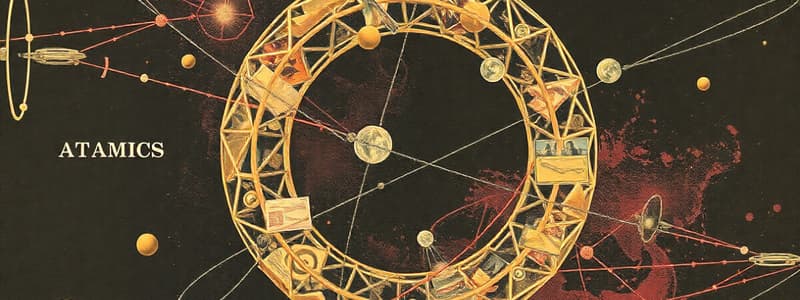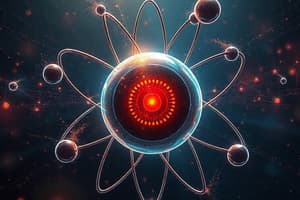Podcast
Questions and Answers
Which of the following statements is a key postulate of Dalton's Atomic Theory?
Which of the following statements is a key postulate of Dalton's Atomic Theory?
- Compounds are formed by the combination of atoms in fixed ratios. (correct)
- Chemical reactions involve the creation of new atoms.
- All matter is composed of divisible particles.
- Atoms of different elements can be identical in properties.
What is the primary characteristic of electrons as described in the study notes?
What is the primary characteristic of electrons as described in the study notes?
- They have a positive charge and define the atomic number.
- They occupy energy levels around the nucleus in various orbitals. (correct)
- They are the heaviest subatomic particles in an atom.
- They are located in the nucleus and have a significant mass.
In Thomson's model of the atom, what does the 'positively charged soup' represent?
In Thomson's model of the atom, what does the 'positively charged soup' represent?
- The fixed structure of the protons in the nucleus.
- The overall neutral charge of the atom. (correct)
- The electron cloud surrounding the nucleus.
- The orbits in which electrons travel.
Which aspect of Bohr's model distinguishes it from previous atomic models?
Which aspect of Bohr's model distinguishes it from previous atomic models?
What role do protons play in an atom?
What role do protons play in an atom?
What can be inferred about the mass of an electron compared to a proton?
What can be inferred about the mass of an electron compared to a proton?
Which of the following best describes the overall structure of an atom as per Bohr's model?
Which of the following best describes the overall structure of an atom as per Bohr's model?
In Thomson's 'plum pudding' model, what does the 'plum' refer to?
In Thomson's 'plum pudding' model, what does the 'plum' refer to?
The rearrangement of atoms in chemical reactions according to Dalton's theory means that:
The rearrangement of atoms in chemical reactions according to Dalton's theory means that:
Which statement about subatomic particles is correct?
Which statement about subatomic particles is correct?
Flashcards are hidden until you start studying
Study Notes
Subatomic Particles Study Notes
Dalton's Atomic Theory
- Proposed by John Dalton in the early 19th century.
- Key Postulates:
- All matter is composed of atoms, indivisible and indestructible.
- Atoms of a given element are identical in mass and properties.
- Compounds are formed by the combination of atoms in fixed ratios.
- Chemical reactions involve the rearrangement of atoms, not their creation or destruction.
Thomson's Model
- Proposed by J.J. Thomson in 1897 after discovering the electron.
- Known as the "plum pudding model."
- Key Concepts:
- Atoms are made up of negatively charged electrons distributed in a positively charged "soup."
- The positive charge balances the negative charge, creating a neutral atom.
- This model depicted the atom as a homogeneous sphere.
Bohr's Model
- Developed by Niels Bohr in 1913 to improve on Rutherford's model.
- Key Features:
- Electrons travel in specific circular orbits (energy levels) around the nucleus.
- Each orbit corresponds to a specific energy level; electrons can jump between levels.
- Incorporates quantization of electron energy levels, explaining the emission of spectra.
- Central nucleus contains protons (and neutrons) with all mass concentrated there.
Electrons
- Subatomic particles with a negative charge (-1 elementary charge).
- Essential Characteristics:
- Mass: Approximately 1/1836 of a proton.
- Occupy energy levels around the nucleus in various orbitals.
- Involved in chemical bonding and reactions.
- Contribute to an atom's electrical properties.
Protons
- Positively charged subatomic particles (+1 elementary charge).
- Essential Characteristics:
- Mass: Approximately 1 atomic mass unit (amu), similar to that of neutrons.
- Located in the nucleus of an atom.
- Define the atomic number, determining the element's identity.
- Influence chemical behavior through their number and arrangement with electrons.
Dalton's Atomic Theory
- Proposed by John Dalton in the early 19th century
- Atoms are the smallest unit of matter and cannot be broken down into smaller particles
- Atoms of the same element are identical in mass and properties
- Atoms of different elements combine to form compounds
- Chemical reactions involve rearrangement of atoms, not creation or destruction
- This model laid the foundation for modern atomic theory
Thomson's Model
- Proposed by J.J.Thomson in 1897 after discovering the electron
- Known as the "plum pudding model"
- Depicted the atom as a sphere with a positive charge and negative electrons embedded throughout
- Modeled the atom similar to a plum pudding, with electrons as the "plums" in the positive "pudding"
- This model was inaccurate but important for recognizing the existence of subatomic particles
Bohr's Model
- Developed by Niels Bohr in 1913 to improve on Rutherford's model
- Electrons orbit the nucleus in specific energy levels
- Electrons can jump between energy levels by absorbing or releasing energy
- The model explained the emission of spectra due to the quantization of electron energy levels
- The nucleus was the center of the atom, containing protons (and later discovered - neutrons)
- This model was a major improvement over previous models but still simplified and had limitations
Electrons
- Negatively charged subatomic particles
- Mass is approximately 1/1836 of a proton
- Located in specific orbitals surrounding the nucleus
- Their arrangement and number determine the element's chemical properties
- Involved in chemical bonding and reactions
Protons
- Positively charged subatomic particles
- Mass is approximately 1 atomic mass unit (amu), similar to neutrons
- Located in the nucleus of an atom
- Define the atomic number of an element
- Influence chemical behavior through their number and arrangement with electrons
Studying That Suits You
Use AI to generate personalized quizzes and flashcards to suit your learning preferences.




